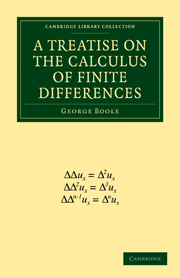Book contents
- Frontmatter
- Preface
- Contents
- CHAPTER I NATURE OF THE CALCULUS OF FINITE DIFFERENCES
- CHAPTER II DIRECT THEOREMS OF FINITE DIFFERENCES
- CHAPTER III OF INTERPOLATION
- CHAPTER IV FINITE INTEGRATION
- CHAPTER V CONVERGENCY AND DIVERGENCY OF SERIES
- CHAPTER VI THE APPROXIMATE SUMMATION OF SERIES
- CHAPTER VII EQUATIONS OF DIFFERENCES
- CHAPTER VIII EQUATIONS OF DIFFERENCES OF THE FIRST ORDER, BUT NOT OF THE FIRST DEGEREE
- CHAPTER IX LINEAR EQUATIONS WITH VARIABLE COEFFICIENTS
- CHAPTER X OF EQUATIONS OF PARTIAL AND OF MIXED DIFFERENCES, AND OF SIMULTANEOUS EQUATIONS OF DIFFERENCES
- CHAPTER XI OF THE CALCULUS OF FUNCTIONS
- CHAPTER XII GEOMETRICAL APPLICATIONS
- Answers to the Exercises
CHAPTER III - OF INTERPOLATION
Published online by Cambridge University Press: 29 August 2010
- Frontmatter
- Preface
- Contents
- CHAPTER I NATURE OF THE CALCULUS OF FINITE DIFFERENCES
- CHAPTER II DIRECT THEOREMS OF FINITE DIFFERENCES
- CHAPTER III OF INTERPOLATION
- CHAPTER IV FINITE INTEGRATION
- CHAPTER V CONVERGENCY AND DIVERGENCY OF SERIES
- CHAPTER VI THE APPROXIMATE SUMMATION OF SERIES
- CHAPTER VII EQUATIONS OF DIFFERENCES
- CHAPTER VIII EQUATIONS OF DIFFERENCES OF THE FIRST ORDER, BUT NOT OF THE FIRST DEGEREE
- CHAPTER IX LINEAR EQUATIONS WITH VARIABLE COEFFICIENTS
- CHAPTER X OF EQUATIONS OF PARTIAL AND OF MIXED DIFFERENCES, AND OF SIMULTANEOUS EQUATIONS OF DIFFERENCES
- CHAPTER XI OF THE CALCULUS OF FUNCTIONS
- CHAPTER XII GEOMETRICAL APPLICATIONS
- Answers to the Exercises
Summary
1. The word interpolate has been adopted in analysis to denote primarily the interposing of missing terms in a series of quantities supposed subject to a determinate law of magnitude, but secondarily and more generally to denote the calculating, under some hypothesis of law or continuity, of any term of a series from the values of any other terms supposed given.
As no series of particular values can determine a law, the problem of interpolation is an indeterminate one. To find an analytical expression of a function from a limited number of its numerical values corresponding to given values of its independent variable x is, in Analysis, what in Geometry it would be to draw a continuous curve through a number of given points. And as in the latter case the number of possible curves, so in the former the number of analytical expressions satisfying the given conditions, is infinite. Thus the form of the function—the species of the curve—must be assumed a priori. It may be that the evident character of succession in the values observed indicates what kind of assumption is best. If for instance these values are of a periodical character, circular functions ought to be employed. But where no such indications exist it is customary to assume for the general expression of the values under consideration a rational and integral function of x, and to determine the coefficients by the given conditions.
- Type
- Chapter
- Information
- A Treatise on the Calculus of Finite Differences , pp. 28 - 44Publisher: Cambridge University PressPrint publication year: 2009First published in: 1860



